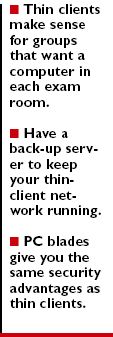Article
Look ma-no desktop
Technology Consult

Missing is the familiar box or tower that houses the electronic guts of a desktop computer. It's been replaced by a device about the size of a hardcover book that connects the monitor to a server down the hall.
Unlike a standard desktop, Wilson's "computer" has no hard drive, so he doesn't have to worry about it crashing. Nor does he have to worry about an identity thief stealing it, because it doesn't store patient information. There are no floppy or CD drives that a snoop can use to download data, or that a goof-off employee can use to install a game. It can't be infected by a virus, so it doesn't need antivirus software. The thing just sits there, staying out of trouble and making Wilson very happy.
Welcome to thin-client computing, which is making inroads in medicine as doctors seek to eliminate the maintenance and security hassles associated with traditional desktops. To understand this trend, a thumbnail sketch of computer networking is in order.
Thin clients-the return of dumb terminals
In geek speak, the term "client" usually refers to a computer that accesses data files and other resources found on a server. In a thin-client network, most of the data processing occurs at the server level, meaning that the client is "thin" on computer duties, regardless of what kind of workstation you're using. In Doug Wilson's office, though, thin client refers to that little piece of connective hardware that replaces the bulky box or tower.
Of course, the hottest network hardware in healthcare these days is the wireless tablet. But a substantial minority of doctors prefer stationary computers. They're not as easily stolen or broken as a tablet, and wired connections are more reliable than wireless ones, notes Dave Ott, vice president of technical services with NextGen Healthcare Information Systems, which sells EHR and practice management software.
But a big fleet of desktops represents a maintenance headache. Each one has an operating system and application programs that must be upgraded regularly. Likewise, each one needs defenses against viruses, spyware, and the like. You also have to undo damage inflicted by staffers who, say, mess with desktop settings.
Thin clients, however, let people connect directly to a tightly controlled server for their computing needs. Most are stationary, although you can find mobile ones, too-a tablet without a hard drive. They're modern versions of the "dumb terminals" prevalent before the arrival of personal computers, says Brad Rowland, an executive with Wyse Technology, which makes thin clients.
Because you mostly concentrate on keeping the server humming, thin clients dumb down network maintenance. True, they have simple operating systems that may require occasional updates, but it's nothing compared to the constant tweaking of Windows XP on a desktop. With no moving parts, thin clients stay on the job longer than desktops, generate less heat, consume less power, and don't make any noise. Their smaller footprint conserves precious space in an exam room.
Being "dumb" also makes thin clients appealing in the HIPAA era. The only way to download data through Doug Wilson's thin client is through USB ports, but these are disabled by default.
And now the icing on the cake-a thin client can lower your hardware bill. A 2005 study from IDC, an IT research firm, showed that the average price for a workstation built around a thin client was $276 less than one with a business-grade computer. You may need an extra server-specifically, a terminal server-to support your thin clients, but you still can save 10 percent on overall hardware costs, says IDC analyst Robert O'Donnell.





